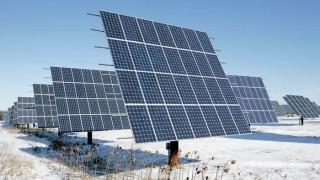Just north of Delavan, Wisconsin, is Dan Osborne’s nursery farm. Where you once found a bean field now sit 80 solar panels on 100 tracking towers, generating renewable power for over 125 homes. It’s a small, but successful community-owned energy harvest. The solar farm was developed by Convergence Energy of Lake Geneva, WI and has owners from all around the region.
In an interview with John Farrell and Wade Underwood of the Institute for Local Self-Reliance, Steve Johnson of Convergence explained, “The genesis of the project from the beginning was to try and provide an offsite location for individuals interested in investing in solar.” It’s just one part of a distributed renewable energy revolution that’s likely to – as Grist’s own David Roberts said, “completely f*ck up the utility business model.”
Listen to the Podcast: Play in new window | Download | Embed
Click to subscribe to Local Energy Rules: iTunes or RSS/XML
Many individuals interested in going solar can be stymied because their property has tree cover or inadequate roof space, or they don’t own their rooftop. Dan Osborne’s fields offered an alternative: sharing in the energy from a community solar project.
Dan, who had worked with Convergence in the past, offered up 14 acres of his farm for the 660 kilowatt (kW) facility outside of Delavan. From there, Convergence arranged for 33 individual Limited Liability Companies to invest in 20 kW increments, which are sold back to the utility at retail price as a part of the state’s net-metering policy (note: unlike others, this utility’s net metering policy does not require the solar project to offset on-site load). The state’s net metering policy caps projects at 20 kW, hence the 33 separate companies.
In addition to receiving the retail electricity price for solar electricity produced, the projects also received grants from the state’s Focus on Energy program and used the cash grant option (since expired) in lieu of the 30% federal tax credit. Project investors signed up for either an 11-year or 20-year investment term (with an 8% return on investment) after which the project ownership reverts to Convergence Energy.
As Steve says, their investors are happy with the solar farm, but there have been precious few opportunities for similar networked projects to grow. The federal cash grant program has expired. The state’s Focus on Energy incentives have been reduced. Few other utilities allow net metering reimbursement if it’s not produced on-site – only eight states have policies that expressly require such “virtual net metering.”
Although Convergence Energy hasn’t been able to replicate the program in Wisconsin, the continued drop in the cost of solar (and increasing utility rates) is driving more electricity customers to look to producing their own clean power. Community solar projects have been sprouting up in other parts of the country, featuring new barrier-busting strategies. The Clean Energy Collective has a community solar model that’s working in diverse places like Colorado, Minnesota, New Mexico and Vermont. Mosaic has launched a crowdfunding platform that will make it even easier for neighbors to pool their resources to generate their own renewable energy.
It might be just one bean field in Wisconsin so far, but the community solar project on Dan Osborne’s bean field is part of a paradigm shift toward more community-based renewable energy.




